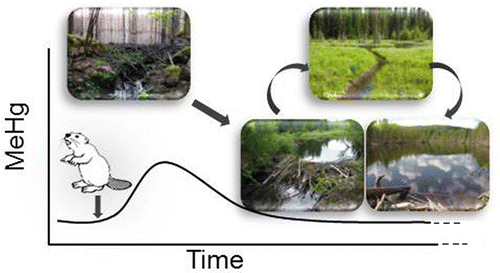A potential downside to the beaver's comeback

The Eurasian beaver was brought back from near extinction and now thrives across Europe. But this conservation success story may have had at least one unintended and potentially harmful consequence. Scientists report in ACS' journal Environmental Science & Technology that when beavers build new dams where no previous beaver colonies existed, downstream levels of toxic methylmercury rise, at least temporarily.
In the 19th century, beaver fur was in high demand, and hunters helped supply it. The animals' numbers plummeted to as few as 1,200 in Europe, with no reported sightings in Sweden after the 1870s. Conservation measures allowed beaver populations to rebound. In Sweden alone, there are now about 130,000—and many new dams. While the structures are marvels of natural construction, they also change the chemistry of the water they're in. They affect the sediments, water flow, oxygen content and temperature, creating conditions that help convert mercury into methylmercury. A few studies have suggested dams can boost levels of this form of mercury, which can cause developmental and neurological problems in animals and people. Oded Lavnoni, Frauke Ecke and colleagues wanted to take a closer look.
Over a two-year period, the researchers tested the water upstream and downstream of 12 dams. They found that methylmercury levels downstream of newly made dams were up to 3.5 times higher than in the upstream water. But dams that beavers reconstructed on abandoned beaver systems didn't appear to affect methylmercury concentrations. The results suggest that protecting older dams could help reduce levels of methylmercury in areas colonized by the animals.
More information: Oded Levanoni et al. Impact of Beaver Pond Colonization History on Methylmercury Concentrations in Surface Water, Environmental Science & Technology (2015). DOI: 10.1021/acs.est.5b03146
Abstract
Elevated concentrations of methylmercury (MeHg) in freshwater ecosystems are of major environmental concern in large parts of the northern hemisphere. Beaver ponds have been identified as a potentially important source of MeHg. The role of beavers might be especially pronounced in large parts of Europe, where beaver populations have expanded rapidly following near-extirpation. This study evaluates the role of the age and colonization history (encompassing patterns of use and reuse) of ponds constructed by the Eurasian beaver Castor fiber in regulating MeHg concentrations in Swedish streams. In 12 beaver systems located in three regions, we quantified MeHg concentrations together with other relevant parameters on five occasions per year in 2012–2013. Five were pioneer systems, inundated for the first time since beaver extirpation, and seven were recolonized, with dams reconstructed by newly recolonizing beavers. MeHg concentrations in pioneer but not in recolonized beaver systems were up to 3.5 fold higher downstream than upstream of the ponds, and varied between seasons and years. Our results show that pioneer inundation by beavers can increase MeHg concentrations in streams, but that this effect is negligible when dams are reconstructed on previously used ponds. We therefore expect that the recovery and expansion of beavers in the boreal system will only have a transitional effect on MeHg in the environment.
Journal information: Environmental Science & Technology
Provided by American Chemical Society



















